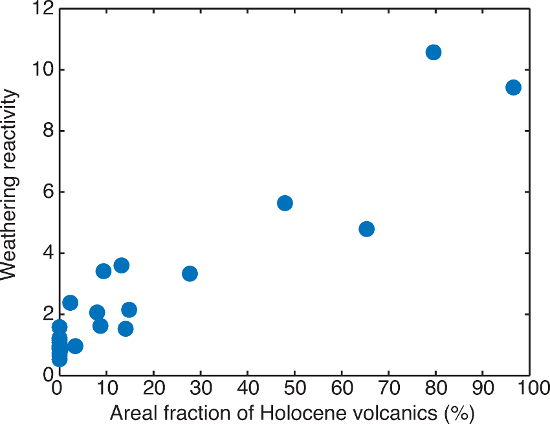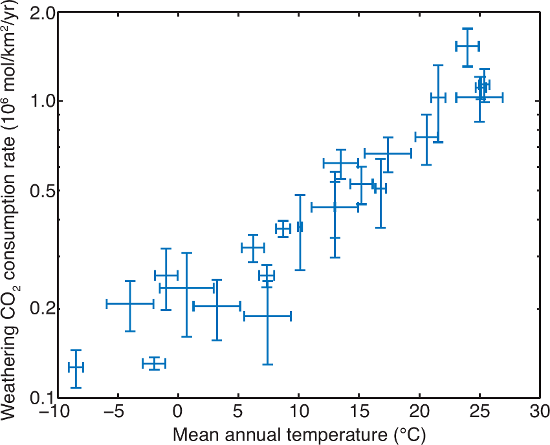September 2019 LIP of the Month
Chemical weathering of LIPs: age and temperature dependence
Gaojun Li
MOE Key Laboratory of Surficial Geochemistry, Department of Earth and Planetary Sciences, Nanjing University, Nanjing 210023, China
E-mail: ligaojun@nju.edu.cn
Extracted from:
Börker, J., Hartmann, J., Romero-Mujalli, G., Li, G., 2019. Aging of basalt volcanic systems and decreasing CO2 consumption by weathering. Earth Surf. Dynam., 7(1), 191-197.
Li, G., Hartmann, J., Derry, L.A., West, A.J., You, C.-F., Long, X., Zhan, T., Li, L., Li, G., Qiu, W., Li, T., Liu, L., Chen, Y., Ji, J., Zhao, L., Chen, J., 2016. Temperature dependence of basalt weathering. Earth Planet. Sci. Lett. 443, 59-69.
Li, G., Elderfield, H., 2013. Evolution of carbon cycle over the past 100 million years. Geochim. Cosmochim. Acta 103, 11-25.
For full details, see these references
Summary
Chemical weathering is arguably the most crucial and fundamental phenomenon on the Earth’s surface. Most notably, the negative feedbacks between pCO2 (climate) and weathering consumption rate of atmospheric CO2 may have helped to maintain the balance of the carbon cycle and the habitability of the Earth over timescales of millions of years (Walker et al., 1981). Basaltic fields have been the focus of recent studies of weathering processes due to their disproportional share (~30%, Gaillardet et al., 1999; Dessert et al., 2003) of the global weathering flux relative to their small areal coverage of ~3.5% (Hartmann and Moosdorf, 2012). Deciphering the factors that control basalt weathering is of great importance for understanding the impact(s) of Large Igneous Provinces (LIPs) on climate change. Age and temperature seem to be the major controls on the weathering of basaltic fields (Li et al., 2016; Börker et al., 2019).
Age Dependence
It has been long been noticed that newly erupted volcanic fields generally show a much higher weathering flux compared to the older volcanic fields under the same climate conditions (e.g., Louvat et al., 2008). Higher weathering reactivity of fresh volcanic rocks has been frequently inferred to explain the impact of large scale eruption on climate change (Gernon et al., 2016). Thus, parameterizing the influence of age on the weathering rate is critical to assess influence of volcanic eruption on global carbon cycle.
Recent work shows that the influence of age can be parameterized by the areal coverage of Holocene volcanic rock (Börker et al., 2018). Higher volcanic activity is generally associated with higher areal coverage of Holocene volcanic rock. The weathering reactivity of the volcanically active region, which is defined by dividing its weathering flux to the that of the inactive volcanic region under the same temperature, using the established temperature dependence of basalt weathering in inactive volcanic fields (Li et al., 2016), shows a strong correlation to the areal coverage of Holocene volcanic rock (Fig. 1). The correlation indicates that region with pure Holocene volcanic rock has weathering reactivity more than 10 times the volcanically inactive fields. The presence of large quantities of fresh volcanic ash may explain the higher weathering reactivity of the volcanically active region.

Figure 1. Cross-plot between the areal fraction of Holocene volcanics and the weathering reactivity of global basaltic catchments. Adapted from Börker et al. (2019).
Temperature Dependence
In the volcanically inactive fields, where the complexities associated with reactive volcanic ash can be avoided, it has been shown that the rate of basalt weathering, as approximated by the consumption rate of atmospheric CO2, correlates well with temperature (Fig. 2; Li et al., 2016). This observation also show that precipitation/runoff acts a minor role in basalt weathering. The observed correlation between weathering rate and runoff is largely caused by the high weathering reactivity of the active volcanic fields which usually have high orographic rainfall (Li et al., 2016). The limited influence of runoff on the weathering rate of basalt may be related to the high concentration of chemical saturation of basalt weathering so that the weathering reaction is far from equilibrium and thus is not sensitive of runoff dilution.

Figure 2. Cross plot between mean annual temperature and weathering CO2 consumption rate of volcanically inactive basaltic fields. Updated from Li et al. (2016).
The observed climate dependence of basalt weathering in volcanically inactive fields would favor a ‘kinetically-limited’ weathering regime. A ‘kinetically-limited’ weathering regime is generally associated with high erosion rates so that the residence time of regolith is short and the weathering intensity of the eroding materials is relatively low (West et al., 2005). Thus, weathering flux is not limited by the supply of bedrock but rather by environmental factors (West et al., 2005). However, detailed investigation shows that LIPs on stable cratons with extremely low erosion rates, such as the Deccan Traps, the Siberia Traps, the Parana Traps, and the Karoo in South Africa, retain a weathering rate that is consistent with the temperature dependence, identified mainly on rugged inactive volcanic islands. Rock detachment and thus denudation, controlled by chemical weathering is suggested to reconcile the paradox between the observed temperature dependence of chemical weathering rate and the low denudation rate of the LIPs.
Implications
The identification of age and temperature dependence would enable calculation of global basalt weathering flux using geological maps and climate records, which results in global basalt weathering CO2 consumption flux of 3.3(±0.2)×1012 mol/yr, which is about 35% of global continental silicate weathering flux. Weathering of purely Holocene areas contribute a CO2 consumption flux of 0.2 ×1012 mol/yr. The contribution of basalt weathering to global flux would be even much higher in the warmer world of the past due to the temperature dependence. The large weathering flux, strong climate sensitivity, and the ongoing renewing of volcanic rocks on the Earth’s surface make basalt the most likely candidate to maintain the balance of the carbon cycle and the habitability of the Earth (Li and Elderfield, 2013).
These findings also suggest that the influence of LIP eruptions on climate depends on the time-scale. Episodic cooling may prevail on an annual timescale associated with volcanic events because of short-lived sulfate aerosols. Periods of intensive eruptions and concomitant CO2 degassing may cause global warming due to the relatively extended lifetime of CO2 in the atmosphere. Decreasing volcanic activities after the main eruption period may introduce cooling due to the rapid consumption of atmospheric CO2 by the fresh volcanic ash. On the timescale of a million years, LIPs may act as a buffering system that helps to maintain the balance of carbon cycle and the long-term habitability of the Earth.
References
Börker, J., Hartmann, J., Romero-Mujalli, G., Li, G., 2019. Aging of basalt volcanic systems and decreasing CO2 consumption by weathering. Earth Surf. Dynam., 7(1), 191-197.
Dessert, C., Dupré, B., Gaillardet, J., François, L.M., Allègre, C.J., 2003. Basalt weathering laws and the impact of basalt weathering on the global carbon cycle. Chem. Geol., 202(3-4), 257-273.
Gaillardet, J., Dupré, B., Louvat, P., Allègre, C.J., 1999. Global silicate weathering and CO2 consumption rates deduced from the chemistry of large rivers. Chem. Geol., 159(1-4), 3-30.
Gernon, T.M., Hincks, T.K., Tyrrell, T., Rohling, E.J., Palmer, M.R., 2016. Snowball Earth ocean chemistry driven by extensive ridge volcanism during Rodinia breakup. Nature Geosci, 9(3), 242-248.
Hartmann, J., Moosdorf, N., 2012. The new global lithological map database GLiM: A representation of rock properties at the Earth surface. Geochemistry, Geophysics, Geosystems, 13(12), Q12004.
Li, G., Elderfield, H., 2013. Evolution of carbon cycle over the past 100 million years. Geochim. Cosmochim. Acta, 103(0), 11-25.
Li, G. et al., 2016. Temperature dependence of basalt weathering. Earth Planet. Sci. Lett., 443, 59-69.
Louvat, P., Gislason, S.R., Allègre, C.J., 2008. Chemical and mechanical erosion rates in Iceland as deduced from river dissolved and solid material. Am. J. Sci., 308(5), 679-726.
Walker, J.C.G., Hays, P.B., Kasting, J.F., 1981. A negative feedback mechanism for the long-term stabilization of Earths surface temperature. J. Geophys. Res., 86(C10), 9776-9782.
West, A.J., Galy, A., Bickle, M., 2005. Tectonic and climatic controls on silicate weathering. Earth Planet. Sci. Lett., 235(1-2), 211-228.
